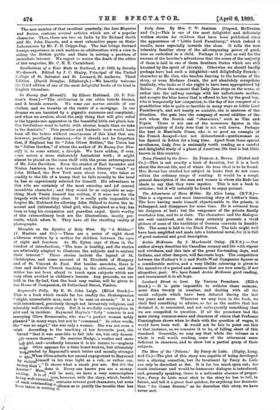Lady Jane. By Mrs. C. - V: Jamison. (Osgood, McIlvaine, and
Co.)—This is one of the most delightful and delicately
written stories for children that have been published since the appearance of "Little Lord Fauntleroy," which indeed it recalls, more especially towards the Giese. It tells the now tolerably familiar story of the all-conquering power of good-.
ness as embodied in a child. Perhaps it is just as well for the success of the heroine's adventures that the scene of the majority of them is laid in one of those. Southern States which are still
haunted by the spirit of chivalry. Otherwise we should hardly perhaps have had such a delightful—and delightfully French—
character as Mr. Gex, who teaches dancing to the heroine of the story, or even Madame Jozain, the not absolutely scrupulous landlady, who looks as if she ought to have been appropriated by
Balzac. From the moment that Lady Jane steps on the scene, or
rather into the railway carriage with her unfortunate mother, and accepts the'blue heron that is offered to her by the good boy, who is temporarily her companion, to the day of her conquest of a grandfather who is quite as terrible in many ways as Little Lord Fauntleroy's, and not nearly so amiable, she is mistress of the dituation. She gets into the company of moral oddities of the.
dolt whom the Scotch eall " oharacters," such as Tits and Pepsie. There is not one of the numerous figures in the
portrait-gallery of Lady Jane that is net well drawn. Perhaps the best is Marn'selle Diane, who is as good an example of the French decayed—but not disheartened—gentlewoman as has figured in fiction for a long time. Apart from these special excellences, Lady .Tasw is eminently worth reading as a careful and delightful study of a phase qf American life that is but little known in this country.






































 Previous page
Previous page